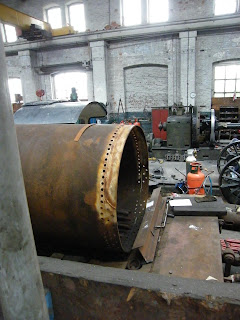Above is 7820's boiler after repairs to the copper firebox plates. Here the repaired plates have been refitted and are held in place with bolts in preparation for riveting and patch screwing the laps back together.
At the front end of the barrel the old tube plate has been removed ready for a new one to be installed. The wasted front lip of the barrel has been cut away and a new section welded in place.
Due to the corrosion and wasteage found in the steel plates a new door plate, side plates and throat plate are required. Above you can see the boiler plate for the new door plate bolted to Dinmore Manor groups new cast former ready for shaping.
The shaping begins, with the plate being heated to enable the metal to be worked around the former using hide mallets. Care has to be taken not to burn the plate and not to force the plate uneavenly thus avoiding cracking or thinning the plate.
Out come the big hammers, with well timed blows three people keep a steady rhythm on the plate working it over the former until it cools and needs reheating.
More heat to keep the metal relaxed and workable.
At the end of the day the plate has been beaten around the former. After cooling and removing from the former the firehole door ring gets turned back to form the lip to which the copper door plate is riveted. This is done in a separate process using a separate former.







Hi all,
ReplyDeleteMost modern boilers have a condensate pipe which transports water away from the boiler. To improve efficiency, the boiler removes as much energy from the flues gases as possible and some of this waste gas cools and turns into a small amount of acidic water. Thanks a lot.......
Water Treatment
Whilst the above is very relavent to a domestic or even commercial central heating boiler, I am not sure the principal tranlates to a steam engine boiler!!
ReplyDelete